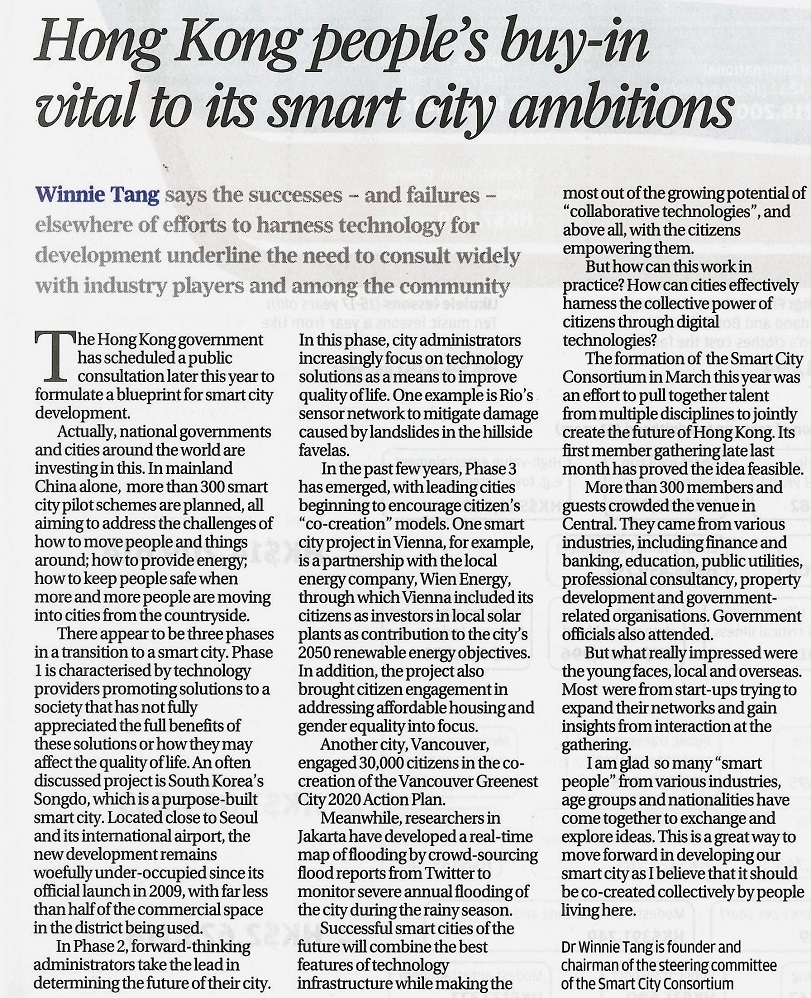網上版請按此

Hong Kong people's buy-in vital to its smart city ambitions
Winnie Tang says the successes – and failures – elsewhere of efforts to harness technology for development underline the need to consult widely with industry players and among the community
The Hong Kong government has scheduled a public consultation later this year to formulate a blueprint for smart city development.
Actually, national governments and cities around the world are investing in this. In mainland China alone, more than 300 smart city pilot schemes are planned, all aiming to address the challenges of how to move people and things around; how to provide energy; how to keep people safe when more and more people are moving into cities from the countryside.
There appear to be three phases in a transition to a smart city. Phase 1 is characterised by technology providers promoting solutions to a society that has not fully appreciated the full benefits of these solutions or how they may affect the quality of life. An often discussed project is South Korea's Songdo, which is a purpose-built smart city. Located close to Seoul and its international airport, the new development remains woefully under-occupied since its official launch in 2009, with far less than half of the commercial space in the district being used.
In Phase 2, forward-thinking administrators take the lead in determining the future of their city. In this phase, city administrators increasingly focus on technology solutions as a means to improve quality of life. One example is Rio's sensor network to mitigate damage caused by landslides in the hillside favelas.
In the past few years, Phase 3 has emerged, with leading cities beginning to encourage citizen's “co-creation” models. One smart city project in Vienna, for example, is a partnership with the local energy company, Wien Energy, through which Vienna included its citizens as investors in local solar plants as contribution to the city's 2050 renewable energy objectives. In addition, the project also brought citizen engagement in addressing affordable housing and gender equality into focus.
Another city, Vancouver, engaged 30,000 citizens in the co-creation of the Vancouver Greenest City 2020 Action Plan.
Meanwhile, researchers in Jakarta have developed a real-time map of flooding by crowd-sourcing flood reports from Twitter to monitor severe annual flooding of the city during the rainy season.
Successful smart cities of the future will combine the best features of technology infrastructure while making the most out of the growing potential of “collaborative technologies”, and above all, with the citizens empowering them.
But how can this work in practice? How can cities effectively harness the collective power of citizens through digital technologies?
The formation of the Smart City Consortium in March this year was an effort to pull together talent from multiple disciplines to jointly create the future of Hong Kong. Its first member gathering late last month has proved the idea feasible.
More than 300 members and guests crowded the venue in Central. They came from various industries, including finance and banking, education, public utilities, professional consultancy, property development and government-related organisations. Government officials also attended.
But what really impressed were the young faces, local and overseas. Most were from start-ups trying to expand their networks and gain insights from interaction at the gathering.
I am glad so many “smart people” from various industries, age groups and nationalities have come together to exchange and explore ideas. This is a great way to move forward in developing our smart city as I believe that it should be co-created collectively by people living here.
Dr. Winnie Tang
Chairman of the steering committee of the Smart City Consortium